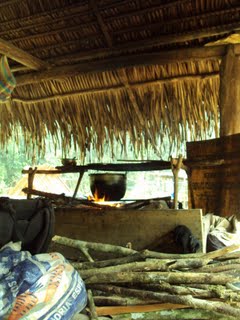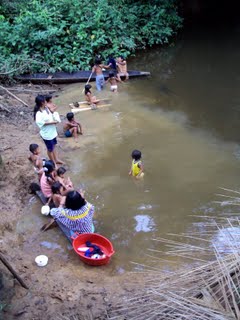The Cofán people are the remnants of a once-numerous riverine culture that has traditionally occupied what is today the northeastern corner of Ecuador and the corresponding region to the north in Colombia.
We have lived for centuries in the forests at the center of the Earth, where the Amazon Basin stretches toward the sky on the slopes of the Andes mountains and its multiple volcanoes.
Today, the Cofan keep our traditions alive and live as we have for hundreds of years. We hunt, fish, use the forest for our daily needs, and our children grow up speaking the ancestral language, A’Ingae. Cofan ancestral territory is among the most biodiverse in the world, demonstrated by various biological inventories done by the Field Museum of Chicago.
Numbering less than two thousand people at this time, the Cofan people have nevertheless established themselves as the vanguard of indigenous conservation efforts, taking on the task of caring for over a million acres of rain forest in Ecuador and large areas in adjacent Colombia.
To learn about our history in more detail: Click Here
To learn about our present day communities, read on.
An Overview of Cofán Territory and Communities
To date, the Cofán have secured the rights to approximately one million acres of our ancestral territory (about the size of the U.S. state of Delaware) that we now protect through agreements with the Ecuadorian Ministry of the Environment and within the National System of Protected Areas. We live in 13 communities in northeastern Ecuador, scattered from high cloud and montane forests down to tropical rain forests. Cofán communities are legally organized according to Ecuadorian laws under “centros” or “comunas,” however Cofán villages maintain leadership structures very similar to their traditional forms.
Cofán Conservation Efforts
The Cofán have fought since the 1970s for the legal right to manage their historical ancestral territories.
The transfer of 136,000 (55,000 hectares) acres to the Cofan Bermejo Ecological Reserve in 2002, home to the Bermejo, Chandia Na’e, Soquié, and Tayosu Canqque Cofán communities, is the first example in Ecuador of federally-protected lands being placed in the official custody of the resident indigenous people. This reserve represents a significant victory for conservation and now serves as an innovative model for science-based land stewardship by indigenous people.
We successfully negotiated a co-management and cooperation agreement in 2002 with the Ecuadorian Ministry of Enivronment to directly protect and manage more than 250,000 acres within the Cayambe-Coca Ecological Reserve, home to the Sinangoe Cofán community and a region rich with tradition for all the Cofán in Ecuador.
In 2004 we gained the rights to the use and management of the 370,600-acreCuyabeno Wildlife Reserve, where the Zábalo Cofán community is located and an area of extremely high biodiversity.
Our most recent success in the recovery of ancient land has been gaining the title to 30,000 hectares in the Rio Cofanes Territory in September 2007, despite severe opposition from many other groups interested in the great wealth that this pristine forest area has to offer, especially in terms of minerals and gold. Click here to view camera trap photos of the endangered mountain tapir in Rio Cofanes.
Finally, the Cofán are currently working on creating a conservation corridor, or franja verde, between the Cofan Bermejo and Cayambe Coca Ecological reserves, an important watershed zone for the country.
Cofán Cultural Centers
Currently, two Cofán community centers, Dureno and Dovuno, remain outside of protected areas. Dureno is the largest Cofán population center and comprises four subcommunities: Dureno, Pisorie Ccanque, Baboroé, and Totoa Nai´qui. Dovuno is a smaller community with its own land base.
Both communities have been heavily affected by uncontrolled colonization and environmental damage from careless management by oil companies. While the Cofán have legal titles to a portion of our traditional territories in these areas, the land base is small and the ecosystem has hit its threshold permitting the Cofán to practice their traditional mode of subsistence. Without strategic conservation activities, these islands of primary forest being squeezed by massive "development" and colonization are at great risk of disappearing and profoundly threatening the survival of the Cofán culture.






